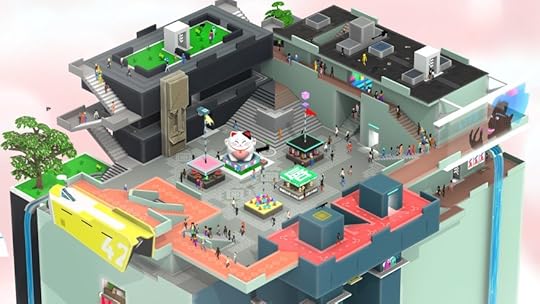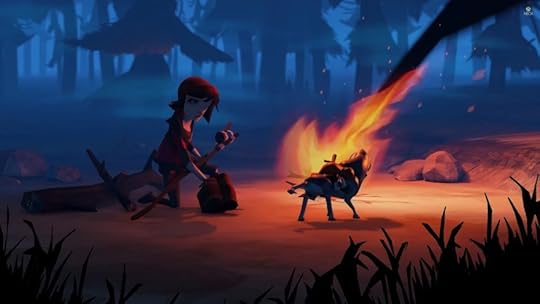Kill Screen Magazine's Blog, page 17
January 11, 2017
Frog Fractions 2 and the difficult art of mystery making
How do you follow up a game like Frog Fractions (2012)? That’s the question its creator Jim Crawford had promised an answer to for two years. On December 27th, 2016, he delivered with the release of Frog Fractions 2, which he had hidden away inside a fairy-themed city builder called Glittermitten Grove.
The problem with making a sequel to Frog Fractions is that it’s a game that relies on the unexpected. The original starts off pretending to teach you about fractions with a simple bug-eating game, but then takes a sudden turn and sends you on a wild adventure, riding a dragon across the courtrooms and porn stores of Bug Mars, weaving in and out of different videogame genres. Having that false front was vital to creating the main thrill of Frog Fractions, and unfortunately you can only truly pull it off once, or so goes the logic.
Crawford didn’t have plans to make a sequel to Frog Fractions immediately. He instead spent most of 2013 doing contract work as the programmer and co-designer on Necrosoft’s mobile game Gunhouse (2016) as he “wasn’t ready to be responsible for [his] own thing just yet.” But while he was working on Gunhouse, Crawford was able to percolate the idea of doing Frog Fractions 2, to the point that he had a skeleton of the game mapped out by January 2014. He even knew how he was going to tackle the biggest problem he would face, which wasn’t making the game itself, but figuring out how to create true surprise around it, as he had done with the first game—he would hide the sequel’s identity from everyone.
“But I wasn’t confident in my ability to pull this sort of game off on purpose,” Crawford told me. The first Frog Fractions was made in the spare time he had while the web design company he worked for slowly cut his hours as it went out of business. “I made Frog Fractions almost by happenstance,” Crawford said. Frog Fractions 2 was being made from a plan, and not only that, it was going to be much larger and would require funding. This meant that this time there would be people who were actively invested in the game’s development, and that raised the stakes.
“a funny, bizarre roller coaster ride”
Apprehensive as he was, what ended up encouraging Crawford was his experience writing the script for his Kickstarter pitch video. “A couple of drafts in, it was pretty solid: a funny, bizarre roller coaster ride, like the original game,” said Crawford. “Being able to just knock that out at will was what gave me the confidence that I was able to just do this sort of thing.” Crawford then spent the next three months gathering friends to help out with the Frog Fractions 2 Kickstarter video. “The highlight of this was a day where nine people got together in my living room to film themselves dressed up as time travelers,” Crawford said. Fun as it was, Crawford reckons those three months were the busiest time of his life: “At the end of it I had $70k in my bank account and also a gum infection that my dentist recognized immediately as ‘acute necrotizing ulcerative gingivitis’, caused by stress and poor nutrition.”
What Crawford pitched to prospective Kickstarter backers was “a weird ride I would release someday, under a different name,” a name that wasn’t “Frog Fractions 2.” At the time, there wasn’t much more to it, because that is how Crawford had started out making the original Frog Fractions: “start with a dumb idea, then grow it based on feedback, relying on what my personal fun/funny considers the obvious next move. Do that for a year and you have Frog Fractions,” Crawford explained. This is why, when he began work on Frog Fractions 2 in April 2014, Crawford had a series of prototypes that he hoped to pull together into a mostly coherent package.
It was at this point that Crawford started to realize how lucky he had been when making the first Frog Fractions, as each of its different parts were made as an extension of the part preceding it, meaning that it all fit together with some sort of story. “And since the first part had a protagonist with a dragon friend, the whole game ended up basically being a buddy comedy about these two characters,” Crawford said. The release plan that Crawford had worked out for Frog Fractions 2 meant that it would be hidden away inside Glittermitten Grove, a city builder that acted as a frame game. “City building games, as it turns out, don’t have protagonists, so I don’t get that for free,” Crawford told me. “And by the time I’d figured out what the start of Frog Fractions 2 was going to be, I’d spent a year making a bunch of basically unrelated game prototypes that were varying degrees of fun/funny.”
The one prototype that showed most promised was called “TXT World.” It was a pastiche of ZZT (1991), DROD (1996), and Insanity (1989), “three PC games that I loved, but very few people have played,” Crawford said. He made this prototype out of obscure games to tackle something that was playing on his mind. “Frog Fractions was ‘outsider art’, and after Frog Fractions, I suddenly became very much an insider, and I mentally compensated for this by making my allusions more wide-ranging and esoteric,” Crawford said. He decided to use “TXT World” as the central hub of Frog Fractions 2, throwing a Legend of Zelda structure onto the ZZT-inspired part, while the other games and prototypes could branch off of it as dungeons to explore, with new abilities and collectibles.
“I had a build playable with a hub and some minigame dungeons at PAX 2015, and I showed it to a few people,” Crawford told me. “One of them was Tim Ambrogi, who’d given me some key advice during the development of Frog Fractions 1. (“Take out the tutorial,” he said.) He told me that the main problem with Frog Fractions 2 was that TXT World was a static hub rather than the descent into madness that the first game was.” Crawford hoped that Ambrogi’s advice would once again let him enact a small change that made the game enormously better. Instead, his advice this time around required months of hard work.
“we tried to create a sense of largeness and history within the content drops”
“I spent the next few months figuring out a game structure that would provide some ways the hub world could be recontextualized with new kinds of gameplay, to provide a sense that you were moving deeper into the rabbit hole.” This is why, as you progress through TXT World, you move through it in different ways to reach new areas. Rollerskates let you slide along walls, a bridge that can be carried around makes it possible to pass through boundaries, a sword can destroy shrubs blocking paths (and open up secret paths), while at one point your character becomes a snake that grows in length upon eating things.
While the madness of Frog Fractions 2 was taken care of, what it still needed was a protagonist to tie the entire experience up. It was Justin Bortnick, the co-developer of Frog Fractions 2, who found the solution when he recommended that they use the tutorial character from Glittermitten Grove as the protagonist. “We ended up cutting her story arc, but simply having a consistent narrator helped a great deal to make it feel like a singular work,” Crawford said. “By the start of 2016, I had a good sense of the shape of what Frog Fractions 2 eventually became.”

While Crawford and his small team spent the rest of 2016 building the rest of Frog Fractions 2, at the same time, two separate alternate reality games (ARGs) were being ran that would eventually unlock the game in its hidden location. One of the ARGs was based on the idea of having a tiny bit of Frog Fractions 2 in many different independent games, appearing as sigils, which was run by Crawford over a period of two years. “The first sigil went into Kingdom of Loathing in August of 2014, people discovered a sigil in Crypt of the Necrodancer in May 2015, people connected the sigils as a thing appearing in multiple games in January 2016, and the final sigil that connected the two ARGs together was discovered in Firewatch [in November 2016], leading to, as you know, soup videos.”
The other ARG was managed by Bortnick, the Frog Fractions 2 co-developer, who set out to use the ARG to build up an elaborate backstory that could be integrated into the game. “Jim wanted Dark Souls (2011) to be a big inspiration, and that game is really good at communicating a world scale with a small amount of information, so we tried to create a sense of largeness and history within the content drops—as if there was always something more behind what the players had, and even then what they had needed a lot of piecing together,” Bortnick said. “I wrote a lot of backstory and even made maps, none of which ended up being released but just served as reference material.”
It quickly got to the point that Bortnick was running the ARG almost entirely by himself, slowly building the Frog Fractions 2 backstory, but also having to change the story as features from the game were cut. For example, originally, Glittermitten Grove was actually called Faeries vs. Badgers, and so the story involved a race of badgers loyal to the anti-faerie resistance. The badgers were cut due to schedule restraints and so Bortnick had to cut the badgers of the story being told through the ARG too.
Nearer the end of 2016, Bortnick was coming up to busy season at grad school, and had to slow down his work on the ARG. It was around this time that Erica Newman got involved who would take the ARG to its conclusion. Newman was one of the players of the ARG and, as she was based near Crawford in the Berkeley area of California, she was chosen to receive a physical box full of sand and sparkles and mazes. “The intention was for her to document opening the box with photos and video for the ARG players on the internet,” Crawford explained. “Instead, she asked for my permission to commandeer the box to take the ARG players on a side-story, another ARG unrelated to but running simultaneously with the existing one. Since my usual mode of operations is to create chaos and try to tie it together into something coherent only when absolutely necessary, I agreed.”
“they therefore treated Jim as a criminal to be imprisoned”
Newman then began work on her “side-ARG,” mostly managing the music, art, websites, clues, writing, video production, and puzzle testing. The people doing the puzzle design and development for her were Justin Melvin and Micah Edwards. “I wanted to return to the aesthetic of the Frog Fractions game and the early parts of the ARG, which were silly, disjointed, and mysterious,” Newman told me. She started out with this on a small scale, intended as a third ARG, but as her ARG ended up being more active than Bortnick’s, the decision was made by Crawford for it to take over as the main Frog Fractions 2 ARG. This is when Newman “faced the challenge of not spoiling that sense of mystery, while tying up the narrative threads to make some sort of sense.”
The final part of the Frog Fractions 2 ARG ended up with an extremely long puzzle chain that resulted in the discovery of a key that was retrieved from Laura Hall’s escape room in Portland, Oregon. There was also a box labeled “launch FF2” that needed the key. “Narratively, the players had been following the story of the ‘Resistance’ for well over a year, a group that was manipulating timelines to prevent an existential threat called the ‘Decay’ from destroying their world and our timeline,” Newman explained. “It became clear to the players that the Resistance believed that the Decay will follow directly from the release of Frog Fractions 2, and they therefore treated Jim as a criminal to be imprisoned.”
“I wrote the end of the ARG to provide the players a choice to use or destroy the box and key that would launch Frog Fractions 2—and the Decay—into the world,” Newman told me. “In the end, humans are curious creatures, no? I had no backup plan if they decided to destroy that box and key. Things might have gotten even more interesting.” As it went, the players decided to risk the threat of the Decay upon the world in order to finally launch Frog Fractions 2 right then. The only question left was where on earth it was. It didn’t take long for internet sleuths to realize that a big update to Glittermitten Grove coincided with the button press of their decision.
You can purchase Glittermitten Grove on Steam. Frog Fractions 2 is hidden away inside.
The post Frog Fractions 2 and the difficult art of mystery making appeared first on Kill Screen.
January 10, 2017
Photography project inspires a videogame about mountains
LA-based digital artist and photographer Carson Lynn is aware of the stigma behind the term “walking simulator.” It’s no coincidence that it’s the title of his latest project and also one of the most divisive terms in videogames. He knows that a lot of people shrug the walking simulator genre off as being games that are simply about walking—as if they were pointless, not even games at all. “I often get the same reaction when someone views my artwork since it’s abstract nature,” Lynn tells me. “Many people don’t want to stop and reflect and think about an artwork, they want it to be immediate and obvious. Artwork can’t be rushed through.”
As Lynn creates photography projects, his work is meant to be engaged with at a close level, especially as his aim is often to “visualize the unknowable and blur the line between reality and virtual reality.” Lynn wants his photos to be observed, but for them to also act as a conduit to deeper thoughts, to help the viewer to question the fidelity of the world around them. In “Obsessive Becoming” he dissects landscapes with his lens to explore their relationship with virtual reality, while “Nowhere Gaze” asks its viewer to see a series of terrain shots not as locations but as images that are open to interpretation and tampering.
“Walking Simulator,” which can be viewed in the gallery on Extramissive Eyes, follows the same path as those prior projects. The idea for it came to Lynn while he was on a trip in Alaska. “I had never been so far from civilization, and the locations I saw reminded me so much of some of my favorite games like Dear Esther and Eidolon,” Lynn says. That merging of mediums—photo and videogame—can be seen in Lynn’s images.
“the player can essentially ‘paint’ with the mountains”
Primarily they capture the cold and rugged textures of Alaska’s mountains, but the photos also add a border that implies an endlessness, as if the world were nothing but fallen snow and hard geology. “I was inspired by a particular glitch common in 3D videogames when there is no skybox present, the skybox turns into an ever-repeating pattern of what is visible,” Lynn tells me. “I utilized Photoshop’s Content Aware Fill tool to visually recreate this effect.”
But Lynn didn’t stop there with his crossover as, about halfway through the project, he starting playing around in Unity and realized that he could create an interactive version of the photos. The result is a game that you can currently download for Mac called Walking Simulator (a Windows version is being worked out). The idea of the game is to walk around and use your first-person view to affect the surroundings.
“I purposefully glitched the skybox and built the game around that concept,” Lynn tells me. “Because the sky is only made up of textures the player is looking or has looked at, the player can essentially ‘paint’ with the mountains to create something completely unique. The textures utilized are all original photos and the landscape is generated from topographic data from the same location where the photos were shot.”
He didn’t stop with the photos and the game either, as Lynn also created a mini album of ambient music, which is meant to serve as a soundscape for the project. The tracks amble along with the sound of diamonds and snowfall, realized through rippling synth music, hopefully inducing a meditative state where you can idly reflect as if alone on the Alaskan mountains.
You can find out more about Walking Simulator on its website. Download the game on itch.io. Listen to the album on Bandcamp.
The post Photography project inspires a videogame about mountains appeared first on Kill Screen.
Sylvio’s bringing its ghostly screeches to consoles this Friday the 13th
Can you hear it? The moans in the static. Yes, it’s unmistakable. It’s saying the esoteric, analog-horror game Sylvio is ghosting its way to PlayStation 4 and Xbox One this week, on Friday the 13th to be precise. Weird message to pick up on an oscilloscope, that.
It’s not quite the original version of Sylvio that we praised so lavishly back in 2015, but a remastered version that is heading to consoles—the tweaks and improvements have already rolled out on the Steam version of the game. The changes include the ability to revisit areas in the game, better hand animations (you spend a lot of time staring at hands), optimized levels, and a smoother experience overall.
combing through eerie sounds from beyond the grave
The rest of Sylvio should remain as it was: the same off-kilter frictions, the same obscuring fog, the same screeching spirits. If you don’t know, the game puts you in the role of ghost hunter Juliette Waters, who tracks down shades, pelts them with iron nails to extinguish them, and then records the buzzing static they leave behind.
The reason to play the game is for the scenes that have you combing through eerie sounds from beyond the grave. You scrub audio reels to pick out words from the ghostly lamentations that Juliette then jots down with a pen on paper. The use of audio throughout to create unsettling what-was-that moments is, in fact, what puts Sylvio on a pedestal. It demands that you listen close, to eavesdrop on the sounds that dislodge your safety, to push your face into the horror.
As we said in our review: “Sylvio is a game of analog textures rubbing each other raw: the hiss of a tape machine, the snap of a lit match. It blows up the oppressive murk of Silent Hill 3’s Lakeside Amusement Park to massive size, choking the player with hazy terror.”
Find out more about Sylvio on its website and Steam page.
The post Sylvio’s bringing its ghostly screeches to consoles this Friday the 13th appeared first on Kill Screen.
January 9, 2017
A videogame about the physical pain of having a body
There really aren’t enough videogames about the physical constraints of the body. We have so many games about wonderful bodies: those that can jump high and run fast, that are shot at with bullets and cannonballs yet miraculously heal of all injury seconds later, bodies that move frictionless throughout the length of their virtual existence. Where are the aches and pains of aging? Where are the stretch marks and permanent pressures of contortion?
It’s the inconsequential freedom of bodies in videogames that is often the greatest source of their fantasy. We would probably all act recklessly in reality if we could be assured that pain and death were temporary states, solvable by chomping on a mushroom, or leaning against a wall for a moment. It’s in its consideration of our physical bodies, the flesh and bone that we are forced to live in, that marks Spherical Constitution as special.
you can imagine the crunching of the spine
To describe it is easy: this is Marble Madness (1984) except the surfaces you roll the ball across are people’s living bodies. It might be the palm of a hand or a whole back, acting as a malleable runway for you to manipulate with your mouse, tilting the contours so that the ball rolls into the hole—an almost disturbing invasion at times. Sometimes you have one body while another level might give you three bodies, balanced atop each other as if gymnasts, limbs splayed all over, outfitted with roads and ramps.
One of the creators, Dennis Carr (the other two being Claire Carré and Longxiao Li), has said that Spherical Constitution is about physical pain, compulsion and contortion. You can feel this as you squish a person in half to create a valid surface for the ball to travel across, at which point you can imagine the crunching of the spine and the pull of the leg muscles that the position would induce. People are treated like puppets but aren’t divorced of feeling; utilized to meet a videogame’s needs at the expense of their comfort.
As the virtual body expresses its mimicry of physical pain you might be reminded of how we abuse our own bodies. We’re not all performing artists but many of us do see it necessary to stretch our limbs to remain limber at the gym or during yoga. Perhaps your job requires you to strain your body through repetitive action or compromising positions. Spherical Constitution makes ground towards videogames that consider the fragility of our physical bodies rather than glorifying a form so fantastic that only a rare few in the physical world could ever match it.
You can download Spherical Constitution for free on Glorious Trainwrecks.
The post A videogame about the physical pain of having a body appeared first on Kill Screen.
January 8, 2017
Weird fiction continues to invade videogames with A House of Many Doors
It was going fine until the Gangleman came. He arrived in the total darkness that my crew and I had been plunged into after the Heartlight had gone out. As Captain, I had made the decision to not sacrifice my own heart nor that of any of my crew to restore the light, and so we made haste towards the City of Keys, the closest refuge to our desperate position. That’s when he came, to the tune of “Gangleman, Gangleman,” a portentous poem written across the ages about his infamous acts of terror. And with that he stole one of my men in his sleep, never to be seen again.
It’s hard to express how small a fraction the Gangleman is to the total number of possibilities in A House of Many Doors, due out for Steam on February 3rd. You could play several hours of the 2D exploration RPG and not hear mention of him once. Or you could advance through one screen and know his immediate horror. If you want to crunch the numbers then, here, there are over 300,000 words in the game that delineate its branching paths and conversations. The Gangleman is about 50 of them.
It’s very similar in format to Sunless Sea
If numbers don’t impress you, good, because it’s not the game’s capacity that strikes me as its best feature. That title belongs to the writing and the world it describes. A House of Many Doors takes place in a “parasite dimension” known as the House. It’s described early on in the game as a place of “endless dark rooms and locked doors. It steals people and things from other worlds.” Your task is to find the answer to three questions: What is the House’s purpose? Who built it? And how can you escape? That could take a very long time and you’ll be pressed to survive for long enough to see the quest to its end.
Of course, as there are so many secrets to tease out and terrors to discover and evade, A House of Many Doors is meant to be replayed. It’s very similar in format to Sunless Sea (2015)—which isn’t surprising given that its part of Failbetter Games’s incubation program—it having you explore a procedurally generated labyrinth as the Captain of a mechanical train with legs known as a Kinetopede. Your first mission is to hunt down the pirates that drilled the memories out of your head before they sell them on the black market. But you can forego it if you wish and travel to anywhere else you like, always at your own risk.
You might, for example, head to the City of Keys, where you can trade goods, write poetry from your experiences, recruit new crew mates, and refuel. If you do head there, you’ll be treated to one of the game’s many wonderful descriptions, such as the one of the Factory, which is “squatting vastly at the centre of the city, a bloated concrete tumour swollen to the size of a dozen castles.” It’s in these moments that the influence of China Mieville and Italo Calvino’s Invisible Cities (1972) becomes most obvious. But the exquisite architecture is only the start, as inside those bulbous walls you can unravel intricate histories, ancient secrets, and complex politics, learning more about the House and using that knowledge to become a major player among its citizens.
The bizarre and terrible is always present at the edges
Outside of the cities, when exploring the labyrinth at large, A House of Many Doors makes a firmer move towards 19th century eldritch horror, with entities like the Gangleman randomly showing up to drain your Sanity meter. The bizarre and terrible is always present at the edges as you discover new locations in search of adventure—it’s possible to find a 10-mile-high abomination made by 10 million conjoined crows, to rig an election in the city of the dead, and sell your teeth to enter the library of a weird arachnid civilization. The stories you collect across your travels can be turned into poems that help to stack up your fame, and as they are procedurally generated, you can happen across titles like “The Troglodyte Vomiting of the Mirrors,” “An Elegy on the Reluctant Hell of Grief,” and “Ode to the Strangling Toad.”
You’ll also encounter other crews in their own strange vehicles, enemies who you can sometimes try to reason with, but will probably have to fight a lot of the time. In the current beta version of the game, the combat seems to be the weakest component, partly because it wasn’t properly explained to me. Battles are played out in real-time-with-pause and involve giving instructions to your crew: you can move them around inside your train, and assign them to certain rooms, but you need to bear in mind their roles—engineers need to fix the Heartlight, gunners should be on the cannons, doctors are able to heal wounds. You also need to bear in mind the distance between your Kinetopede and the enemy’s hull, as this affects your cannon’s accuracy, and if you get close enough you can attempt to board enemy trains as they can yours.
Talking to and upgrading your crew is another key part of the game. You can talk to your top-deck crew to build a better relationship with them, finding out the places they want to travel to, which in turn fills your map with distant locations to aim towards in the hope of returning with new stories. It’s these new experiences that gain you Apprehensions, the unit that can be used to upgrade both yourself as Captain and your crew. That you become more competent in the world of A House of Many Doors by becoming more apprehensive says a lot about the kind of place it is.
Find out more about A House of Many Doors on its website. It’s coming out for Windows and Mac on Steam on February 3rd.
The post Weird fiction continues to invade videogames with A House of Many Doors appeared first on Kill Screen.
January 6, 2017
Night Lights hides a whole other world behind its shadows
“Things are different at night.” A game based on this small sentence could go in any direction, really, but the most obvious path is probably towards horror. Not for Moscow-based game maker Artem Cheranev. He went with making a 2D puzzle game that uses light and shadow so you can move between different dimensions.
Called Night Lights, each level in Cheranev’s upcoming game contains one or more spotlights that illuminate a small area in golden rays. Everything else is in darkness; a contrasting blue to the light’s beam. Sometimes you can use levers or pressure switches to turn the lights off, at other times you’re able to move them along a rail, or rotate their angle, so that they light up different places. You do this because anything that is cast in that golden light is in the day realm where, sometimes, platforms or ladders that were there at night cease to exist.
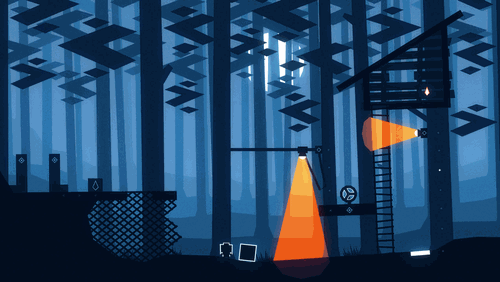
You’d be right for saying that a puzzle game that toys with light and shadow isn’t new. There have been plenty that take this exact idea and spin it with their own yarn: Closure (2012), One Upon Light (2014), and Contrast (2013) for starters, there was even one called Of Light & Shadow (2012). But Cheranev has his own pedigree in this department, having made one of the most memorable Flash games of its time—it was also called Night Lights and can be played on Newgrounds.
lines of light are able to create new spaces through solid architecture
“Back in 2013 I made little browser game with simple lights and shadows mechanics,” Cheranev said. “After that I always wanted to create big polished puzzle game with more complex features, but didn’t have an opportunity until 2016. So now I’m finally working on this project.”
While many of the mechanics have been transferred from the browser game original to this new version of Night Lights, what Cheranev has clearly done a lot of work on its visuals. Not only does the golden light and blue darkness add a striking look to the game, the environments that you puzzle your way through have been vastly improved. Notice how the moon shines through the trees in the forest, how leaves are depicted by chevrons and diamonds, epitomizing the angular style that dominates Night Lights now.
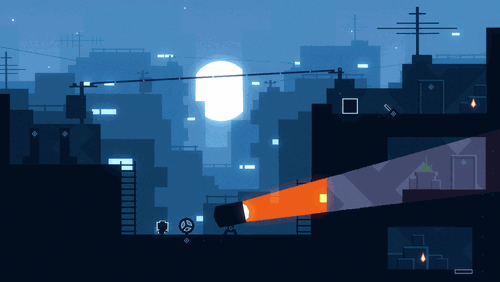
Those sharp lines and corners are more than mere fancy, though, as they’re actually crucial to the game’s concept. The GIF above demonstrates it best, showing how the lines of light are able to create new spaces through solid architecture. As you know, light travels in straight lines, so adding curvature or sticking to anything other than this orthogonal style would complicate each level, not only for Cheranev who has to make it, but for players who have to make sense of it.
Currently, Night Lights exists as a 15 minute demo that you can download either on itch.io or Game Jolt. Play it, have a go, and if you like what you see consider throwing some coin at its Indiegogo campaign. Cheranev has said that he will finish the game regardless of the amount of crowdfunding he acquires. What the money means is that he can work on it full time rather than every spare moment. The release date is brought closer the more money he gets, basically.
Oh, and before you go, it’s worth taking a look at a mobile puzzler called Shifter, which Cheranev made and released back in 2015. It splits its 2D levels into a grid and you can rearrange the tiles to help your character move from location to location, eventually reaching the end. It’s another game that proves his puzzle game pedigree.
You can support Night Lights on Indiegogo. The demo is available to download on itch.io and Game Jolt.
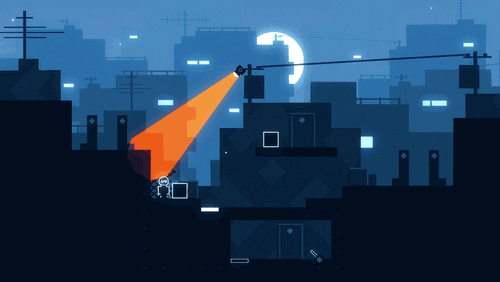
The post Night Lights hides a whole other world behind its shadows appeared first on Kill Screen.
At last, another excuse to stare at the beautiful metropolis of Tokyo 42
Apparently it’s not enough to simply sit and stare at the neat blocks of color that make up the future metropolis of Tokyo 42 (as I spent most of my time doing when I last wrote about it). We need to pay attention to what you can do in these elevated city islands too.
That’s the focus of the latest video released by publisher Mode 7, who says “the game has attracted a bit of a following due to its art style, but now we really want to delve into the gameplay and show people that it plays as nicely as it looks.” Okay, sure, do that, but you can’t stop me getting sidetracked by a particularly neat arrangement of staircases, or the contrasting greens and reds of a pair of cube-apartment tower blocks.
change your skin and try to blend in with the pedestrian crowds
The video is below and comes in at under four minutes so you’ve no good excuse not to give it some of your time. It shows three different ways you could approach infiltrating a single area in one of the game’s missions. Broadly speaking, those approaches are stealth by way of katana, combative with grenade and minigun, and a slightly more smart mix of the two.
While Tokyo 42 does have established “cool” action game features like bullet physics, jumping with air control, and stealthy evasion, the aspect that appeals to me most is found in its crowd simulation. Notice that in the video above it’s mentioned that you can “change your skin,” which is exactly what is sounds like: you can instantly change your appearance so that you can move invisibly past the guards hunting for you. It’s the kind of thing Assassin’s Creed tried to pull off by letting you commit a murder and then slip away into a walking formation of white-cloaked monks.
There’s a bit more flexibility to it in Tokyo 42 as it seems you can change your skin and try to blend in with the pedestrian crowds at any time. Obviously you do need to hide somewhere in order to change your skin but that’s the only big requirement. It’s a neat feature and is probably the most cyberpunk part of the game, besting even the small environmental details like the Jetsons-style cars and moving billboards.
Mode 7 makes a note of how good the skin-changing ability can be in another of the game’s modes (outside of the single player they’ve shown off so far). “A multiplayer arena mode adds a Where’s Wally-slash-Waldo-for-other-territories dimension: change your skin and blend in with the crowd, then explode into view with a flurry of overly ambitious rockets,” Mode 7 wrote. That’s the kind of tactic I know I’ll be exploiting when I get around to playing it.
And when that might be? There’s no specific date outside of 2017 still, but at least we know it’ll be coming to PC, Xbox One, and PlayStation 4. Oh, and by the way, if you have a careful eye you can spot cats wandering the city in Tokyo 42 (I’m not talking about the large cat statue, but actual cats). That’s my kind of feature.
Find out more about Tokyo 42 on its website.
The post At last, another excuse to stare at the beautiful metropolis of Tokyo 42 appeared first on Kill Screen.
Get ready for the twisty geometry of Euclidean Lands to arrive this year
One videogame that should be on your list of ones to watch in 2017 is, without a doubt, Euclidean Lands. It’s the work of Miro Straka, a Slovenian architecture student at the University of Applied Arts in Vienna, who decided to make a puzzle game in his spare time. After a few years he’s coming to a close and is looking to get it out on mobile soon.
You can immediately see the benefits of Straka making a videogame alongside his studies. Each level in Euclidean Lands is a diorama of shifting geometry; impossible feats of architectural complexity. A line like that should immediately draw comparisons with Monument Valley (2014)—an act of flattery that I believe Euclidean Lands holds up to—but there are some big differences between the two.
more rooted in the mechanical puzzles of Ernő Rubik
For starters, while Monument Valley made an effort to be silent with its storytelling for the most part, it looks like Euclidean Lands will feature big bold text that zaps into view at certain moments to surface its narrative. But the biggest distinction, of course, is the level design in both games. Monument Valley took a leaf out of M. C. Escher’s well-work book to blur the line between illusion and reality—separate platforms could be magically joined through perspective alone. Whereas Euclidean Lands is more rooted in the mechanical puzzles of Ernő Rubik (i.e. the Rubik’s Cube), which means you spend your time spinning and rotating structures and walkways to create paths.
The addition of grid-based combat in Euclidean Lands also means it ventures into the territory of Square Enix’s mobile puzzlers, including Hitman GO (2014), Lara Croft GO (2015), and Deus Ex GO (2015). However, Euclidean Lands takes those concepts further due to its commitment to non-reality. In the GO games, for the most part, you have to abide by the laws of gravity, the terrain mostly being fixed. But in Euclidean Lands, because the levels are more toy-like, gravity is constantly shifted (or ignored entirely), as your hero and the enemies move at all angles without restraint.
As we haven’t checked up on Euclidean Lands for quite a while (nearly two whole years) there are plenty of new levels that Straka has been sharing to have a look at. The two below, for example, are a great demonstration of the multiple angles you can approach enemies from.
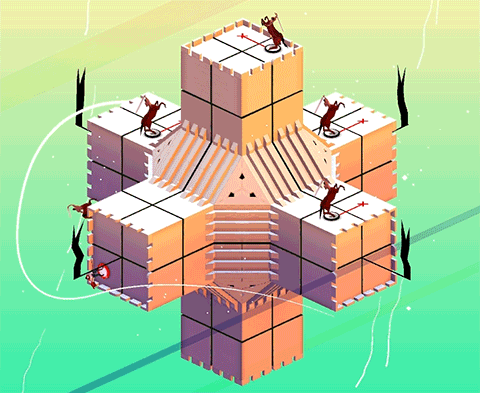

The next GIF proves that it’s not only enemies that endanger you, but also large-ass spikes that piece tiles as you move across them.
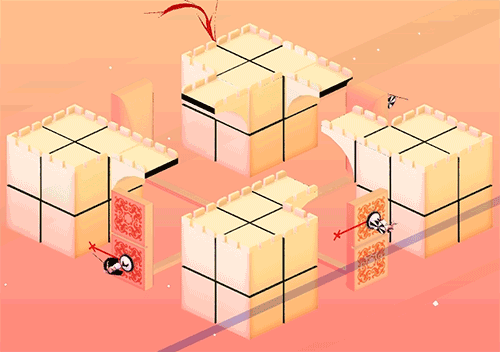
I have to show off the next one as it’s one of the best level select screens I’ve seen. I love how fragments of stony architecture are used to represent levels.

Back to the levels themselves, here we see the game’s bridges in full swing. You’ll need to connect them to cross from cube to cube, at the hazard of running right into an enemy.
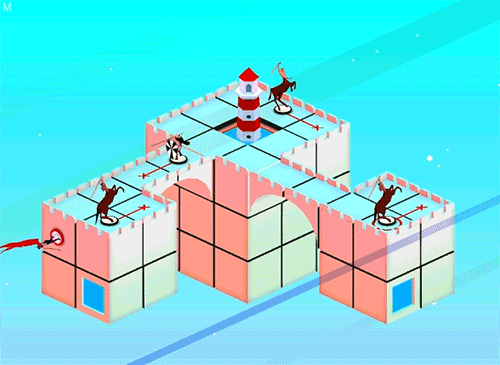
And finally here is one of the boss levels in Euclidean Lands. Looks like a classic goat-like devil figure in this one, who remains still, ready to strike as the player attempts to find an angle to attack from I presume.

That’s all for now. As said, Euclidean Lands is nearly finished and should be out shortly. You can be notified when by signing up on its website.
The post Get ready for the twisty geometry of Euclidean Lands to arrive this year appeared first on Kill Screen.
January 5, 2017
Die along a river when The Flame in the Flood arrives on PS4 this month
If you haven’t played The Flame in the Flood yet then consider this a second chance. Today it was announced that it’ll be coming to PlayStation 4 on January 17th. And not only that, it’ll have some extra goodies to boot in order to justify calling it the “Complete Edition.”
There aren’t too many extras to get excited about in this new package. It includes a director’s commentary, avatars, and a dynamic theme. Oh, and “gameplay enhancements,” which could mean anything, but given that the creators are being vague it’s likely just a bunch of small improvements that even people familiar with the game will hardly notice.
If you missed The Flame in the Flood when it came out for PC and Xbox One last year, you can be forgiven—there were a lot of good games to keep you busy in 2016. It’s worth a visit if you haven’t already checked it out: it’s a twist on the survival game that has you rafting down a river while dealing with the monsters of post-societal America. As well as steering your modifiable raft down the hazardous river, you’ll have to make stops at fractured islands to forage for whatever bits of food you can, and if you should fall sick then you’ll have to hope you come across a remedy at some point too. There are also wolves, boars, and bears to either evade or deal with if you’re able to build a trap and lure it in.
Yes, a little dog that can carry things for you
Alright, that’s pretty standard survival game stuff. The twist here is that you can’t stay in a single place as with most other games in the genre but have to constantly escape from the approaching floods. Keep moving or you’ll die. You’ll die a lot, actually. Which makes it a good job that the river and its surrounding environments are procedurally generated—new surprises with each death!—as noted in our review, it’s a fitting videogame twist on the old adage, “You never step in the same river twice.”
If the game isn’t grabbing you at this point then I have two more features to help lure you in. The first is a dog called Aesop. Yes, a little dog that can carry things for you. It’s great. Plus, anything that Aesop is carrying upon your death will be transferred to your next playthrough. So, yeah, give that dog your best stuff (and some treats). The second feature is the folksy Americana soundtrack provided by bearded outdoor guitarsman Chuck Ragan. (Go on, have a cheeky listen.)
You can find out more about The Flame in the Flood on its website.
The post Die along a river when The Flame in the Flood arrives on PS4 this month appeared first on Kill Screen.
You can sprint across Future Unfolding’s dreamlike meadows very soon
Future Unfolding has looked good for a long time. We first spotted it almost three years ago when we naively said that it would be coming out in 2014. Not a chance. We’ve just entered 2017 and it’s still not out. But it will be out soon. In fact, its arrival is listed on Steam as “Early 2017.” If you haven’t yet recovered from your New Year’s Eve party, let me get you up to speed: that’s where we are right now. Andreas Zecher, one of the people making Future Unfolding, is already prepping for the drop.
As far as can be ascertained from this distance, there are two primary features of Future Unfolding that has taken a few years for its creators to develop and perfect. The first is its vivid and serene visuals, depicting a range of beautiful, naturalistic top-down landscapes, the exploration of which should fuel your time spent with the game. You’re given no instructions and left to figure out what to do for yourself.
That open-ended choice was inspired by the creators’ childhood excursions into the forests of Poland and Sweden. So, it might be that you frolic with bunnies for a while, befriending them so they follow you around, which is bloomin’ delightful let me tell you. But there’s also a chance you could accidentally run into the wolves that divide their bodies in order to multiply their numbers as they relentlessly hunt you down. Yeah, that’s not normal. In fact, that’s also taken from those childhood forests, which were ripe with folklore and strange beasts.
Anyway, to get back to where we were, the most striking aspect of the visuals is the paint smear-like effect that happens when you sprint through patches of flowers, leaving a trail of bold color behind you. Seeing it in a still image can certainly have impact, but you should really see it in full motion, so watch the video below.
The second aspect of Future Unfolding that has surely taken a lot of time is its puzzles. Don’t fret too much, there doesn’t seem to be any hardcore number crunching in the puzzles, they’re more environmental and involve playing around with ecosystems. Here’s a good description from the creators about how these puzzles work: “Future Unfolding paints a world full of life, which follows an underlying logic but where not all connections are immediately clear to the player.”
interact with mystical monuments to be transported to new areas
For example, when I played the game, one puzzle-like element I found was discovering secret areas in the forest by utilizing the liquid the snakes shot at me, which corroded trees and opened up the way. You can also ride some animals and interact with mystical monuments to be transported to new areas. So the puzzles are meant to be intrinsic to the exploration—which is easily the biggest appeal of the game—merely adding soft barriers for a better sense of progression.
What’s most confusing about the puzzles in Future Unfolding is that they are all designed by hand but occur inside the landscapes through the use of procedural generation. That’s what the team behind the game said last year at least. I guess it makes sense when you consider that all of the environments are procedurally generated, and so the puzzles have to be too, but man that sounds like a lot of hassle. Still, I guess the team got through it if the game is to be out soon. Good job.
You can find out more about Future Unfolding on its website. It’ll be coming to PC and PlayStation 4.
The post You can sprint across Future Unfolding’s dreamlike meadows very soon appeared first on Kill Screen.
Kill Screen Magazine's Blog
- Kill Screen Magazine's profile
- 4 followers
















